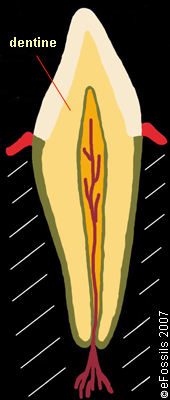
the chief tissue of a tooth; a tissue in the middle of the tooth that surrounds the pulp cavity and is covered by enamel on the crown and cementum on the root of the tooth.
teeth.
a recently acquired trait.
a tool used by hominins to access below ground plant parts such as roots and tubers; can be constructed of wood, bone, horn, or antler.
a relative term used to describe a part of a limb that is farther from the attachment point to the trunk of the body; the opposite of proximal.
the abbreviation for deoxyribonucleic acid.
flexing the foot upwards towards the leg.
eFossils is a collaborative website in which users can explore important fossil localities and browse the fossil digital library. If you have any problems using this site or have any other questions, please feel free to contact us.
Funding for eFossils was provided by the Longhorn Innovation Fund for Technology (LIFT) Award from the Research & Educational Technology Committee (R&E) of the IT governance structure at The University of Texas at Austin.
